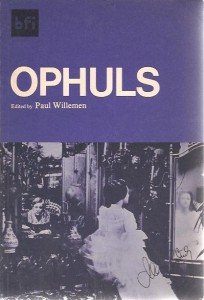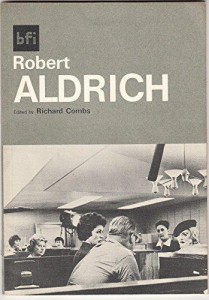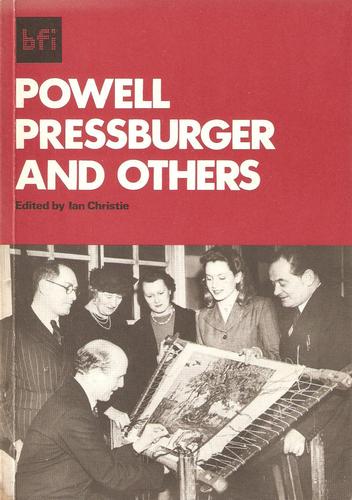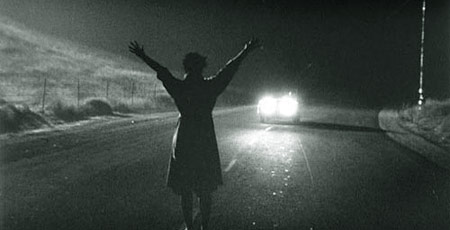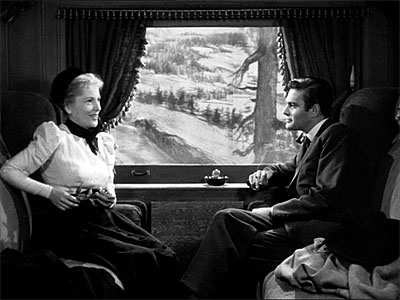From Film Quarterly (Summer 1979). Sad to say, the Aldrich and Ophüls books are now so scarce that I couldn’t even find their jacket illustrations on the Internet until a reader, Luke Aspell, generously furnished them to me. –- J.R.
ROBERT ALDRICH. Edited by Richard Combs. London: British Film lnstitute, 1978. $3.25.
POWELL, PRESSBURGER AND OTHERS. Edited by Ian Christie. London: British Film lnstitute, 1978. $4.50.
OPHÜLS. Edited by Paul Willemen. London: British Film lnstitute, 1978. $3.50.
Perhaps the most striking difference between the current batch of British Film Institute monographs and the previous series issued under the now-defunct aegis of Cinema One (a joint effort of the BFI and the English publisher Secker & Warburg) is the relation of each to academic film studies. The Cinema One books, designed as popular laymen’s introductions to relatively obscure subjects, were lavishly illustrated with stills and frame enlargements, appeared both in paperback and hardcovers, and rarely proceeded beyond the format of one critic per subject.
The new line of BFI books, which appear only in paperback, are much closer to academic “casebooks”: the texts are usually longer, illustrations are omitted (apart from black-and-white stills on the covers), and the critical perspectives in most cases are multiple. There is more than one way of editing a casebook, however; and a closer look at the three titles under review offers some notion of the diversity of positions possible within this overall strategy.
Richard Combs’s Robert Aldrich — the most modest of the trio in aspirations, as well as length (at 75 pages) — most closely resembles a Cinema One volume in its format and scope. Two longish essays, by Combs and Tom Milne, work their way chronologically through Aldrich’s features, the former covering films between 1953 and 1961, the latter tracing the period from l962 to the present; after this comes a recent interview with Aldrich, followed by a biofilmography which seems virtually exhaustive — listing Aldrich’s features as assistant director as well as over a dozen unrealized projects, with additional interview material.
Although Combs appears to be trying to distance himself somewhat from an auteurist approach at the beginning of his essay, it would probably be correct to call the orientation of this book modified auteurism in the Sight and Sound/Monthly Film Bulletin tradition. Duplicity, ambiguity, ambivalence and other forms of dialectical tension in Aldrich films are explored thematically and stylistically in both essays, yielding a criticism of appreciation which stops short at an obvious failure like The Choirboys — whose contradictions might point to an interesting social commentary, but not within this sort of context — yet remains alert to social nuance whenever the critics’ aesthetic imaginations are engaged.
Considering the fact that each title under review is the first full-length book in English devoted to its subject, the challenge in each case is to open up an area for discussion without closing off fruitful alternative options. From this standpoint, Ian Christie’s stimulating 124-page collection offers by far the broadest range of possibilities. It is a long-standing truism that Michael Powell remains the most neglected major figure in English cinema, and the enormous value of this multi-faceted introduction is that it includes not only the best pioneering studies done on Powell in the sixties — by Raymond Durgnat, Thomas Elsaesser, and Jean-Paul Torok — but also groundbreaking new work in theory and research.
John Ellis’s detailed analysis of A Matter of Life and Death (“Watching Death at Work”) could serve as a model for how to apply the theoretical perspectives of Screen to a critical methodology without drowning readers in jargon or alienating them with elitist postures; and as a careful consideration of how narrative, realism, and sexuality are articulated in this film, the observations are both acute and suggestive. Significantly, these are tied to an analysis of the film’s initial press reception, which complements the historical research done elsewhere in the book by the editor: a nearly 50-page “chronicle” (combining biofilmography and bibliography) of the careers of Powell and Emeric Pressburger, his principal collaborator, which leads off the collection; a study of the English press’s scandalized response to Peeping Tom, in relation to the “illicit pleasure principle of cinema” that the film broaches; and a documented account of the diverse efforts made by Winston Churchill to suppress The Life and Death of Colonel Blimp in 1942-43, brought to light by Christie’s own discovery of the relevant correspondence.
On the other side of the spectrum, Paul Willemen’s 87-page Ophüls assigns itself the perverse task of accumulating diverse materials and then striving to give them as little use value as possible, apart from pursuing a parochial exercise in polemical spite. After noting in his Preface that any justification for his editorial choices is “‘impossible’ from a position within the institution,” Willemen starts things rolling with a “Familographic Romance” –- a career chronicle promising a good deal more than Christie’s while delivering considerably less — before proceeding to a set of documents and articles.
Much of the latter will undoubtedly be useful to Ophüls scholars: a Cahiers du cinéma interview, two texts by Ophüls, recent studies by Frieda Grafe, new theoretical texts by Masao Yamaguchi and Willemen himself, and a reprint of Stephen Heath’s “The Question Oshima” (which uses Letter to an Unknown Woman as a reference point) with a postscript added. What remains pointedly absent is any argument as to why anyone should be an Ophüls scholar in the first place. And more casual readers looking for information are likely to be frustrated: an early work as important as La signora di Tutti gets no treatment beyond a short filmographical reference, while the early critical writing of Andrew Sarris on Ophüls isn’t even acknowledged.
In their insistence on playing auteurist games while simultaneously denouncing them as practiced by others, Willemen and Heath promote an unpleasantly self-serving and snobbish stance that dilutes and detracts from the value of their own insights. The idealist model conjured up by Heath for Oshima’s Empire of the Senses, whereby scenes are organized in a pattern of repetition “with no narrative pattern of recall, advance, resolution,” is obviously different in intent from the idealist models of “transcendental” auteurism, but remains idealist none the less; and Willemen’s characterization of Ophüls’ cinema as “the dramatization of repression” continually begs the question of why Ophüls should serve as a more interesting example of this process than any other commercial filmmaker. In both cases, the limitations and tautologies of the reference points insure that the field of inquiry remains narrow, perpetuating the kind of alienating dogmatism that helps to give film theory a bad name. — JONATHAN ROSENBAUM

